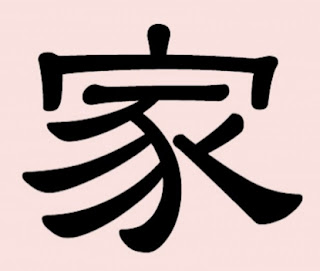Because we have a Chinese-American daughter, our whole family at various times has studied Chinese. At the moment, it's mostly us parents who are studying, because Younger Daughter has been resistant, but I'm hoping to get YD back to it later.
Our teacher is American, and she's been teaching us to read Chinese characters by decomposing the characters into smaller pieces, called "radicals". Here's an example:
In this case, the top part of the character ("jia") represents a roof, and the bottom part of the character represents a pig. A pig under a roof -- what does it mean? Why, home (or, by extension, family), of course!
Here's another one:
Here, the radical in red means "female" (it's a pictograph of a woman), and the radical in black means "horse" (imagine four running feet and a flowing tail at the bottom.) This character represents something female, which sounds like the Chinese word for horse, "ma" (low dipping tone). What is it? It's "ma" (high even tone), which means "mother". (Famous advice to beginning Chinese speakers: "Don't call your mother a horse!")
You can see how decomposing a character into radicals is a big help in memorizing characters. So here's the funny thing — apparently, reading is never taught this way in China. In China, kids are taught to read purely through brute-force memorization. They get a list of characters and are told to write them out multiple times until they've got them memorized. If you talk to a Chinese-taught person about radicals, you're likely to get a blank stare.
I had this experience myself once. I was talking to a Chinese friend of ours, when I noticed the character "jia" in something he was writing. I pointed to it and said, "we were just studying that character! It's a pig under a roof!" He looked at me like I was crazy and said "it means home or family."
It's the Chinese version of whole-language versus phonics.


The Chinese teachers at my school taught characters through "brute-force memorisation" with a countless amount of flash cards. I was lucky enough to work out the system of radicals more or less on my own- I think one of the chapters of the book "Chinese Cinderella" helped a bit. Occasionally I point out radicals to my friend so she can learn about them too. There are times to use pure memorisation (e.g. if you haven't seen a character remotely like the one you're learning) but most of the time it's best just to think of each complex character as a set of simpler ones.
ReplyDeleteWow. I had no idea that Chinese characters could be broken down like that. I've just always assumed I was way too dumb (or poor at memorizing) to be good at a character-based language.
ReplyDeleteThe memorizing v.s. radical debate reminds me of the homework debate here. Nobody seems to be able to prove that most homework aids in learning, but proponents argue that it's good for kids to get used to doing unpleasant tasks, while opponents wonder why we need to intentionally make kids miserable.